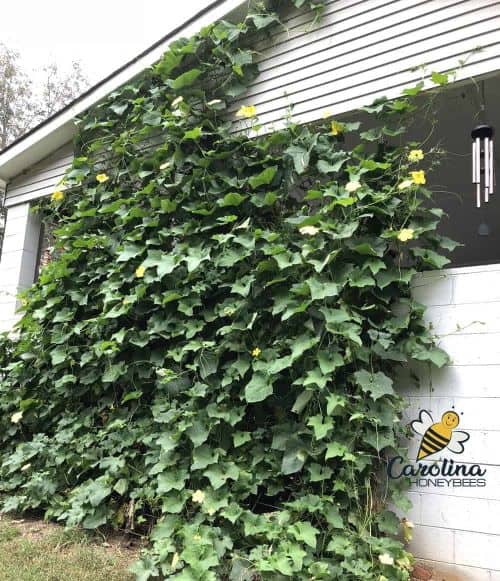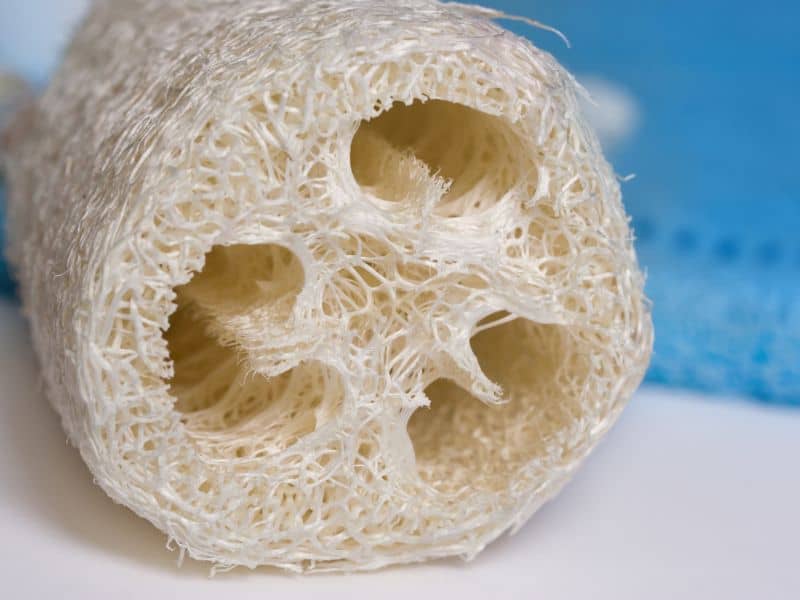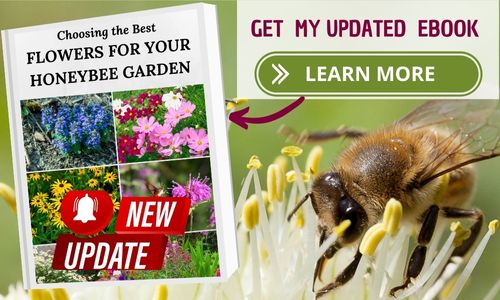Growing Luffa Flowers for Bees & More
Growing luffa flowers for bees is an easy and fun project. Even better, after the bees enjoy the flowers you will be left with a useful sponge! Ok, they are not technically a true sponge – but we use them as such. Bright yellow flowers are a powerful magnet for pollinators. These heat-loving vines produce an abundance of blooms rich in both nectar and pollen—perfect for feeding hungry honey bees and other beneficial insects.

As a beekeeper and gardener, I am constantly looking for new bee plant ideas. Including flowers that bees love in your landscape helps provide a diverse diet for all area pollinators-not just honey bees. And, if the plant is a bit odd, that’s even more exciting.
Why Luffa Flowers are Great for Bees
Luffa plants have separate male and female flowers. The male flowers produce large amounts of pollen that is readily gathered by busy bees.
When the female flowers bloom, nectar is the main reason for insect visitors. Both pollen and nectar from one plant!
This plant may be a little slow to get started but it has a long bloom period. Once they start flowering—typically in midsummer—luffa vines keep blooming until the first frost.
This extended bloom time is especially valuable to bees late in the season, when many spring and early-summer flowers have already faded. This is the time when honey bee colonies are building up stores for winter.
The Luffa flowers can provide food for bees when there is little else out there- during a nectar dearth.
Is it Loofah or Luffa?
There is a bit of a debate on the correct terminology for this plant (Luffa aegyptiaca). Most often, I hear the term “loofah” applied to the fibrous sponge that is the end result.
While the word “luffa” is used to describe the tender fruits – that can actually be eaten while young. I tend to use luffa for all. I am not qualified to get into a debate over plant names.

How to Grow Luffa for Flowers for Bees & Fruit for You
Before you embark on this amazing adventure – and for me it really was. I will give you some important factors to consider. Most importantly – will growing luffa vines work in your climate?
Can You Grow Luffa in Your Area?
Climate and growing conditions should always be considered when choosing plants for bees. Luffa requires a long growing season to produce ripe fruit.
Those with a shorter growing season may see luffa flowers but the fruit may not mature enough to become a sponge. (Well, you know I want those too!)
Start Early with Luffa Seeds
Start your luffa seeds indoors and then transplant the plant outside after the last frost date. Even though I live in the South – I’ve learned to start my seeds at least 6 weeks before the last frost date.
Unless you live in the deep south, sowing seed outside may not result in ripe fruit before frost. You will run out of time.
To increase germination rates, I scarified or scratched (nicked) the seed coat and soaked the seeds for 24 hours before planting in small peat pots.
Luffa seeds are easy to find in early Spring at any garden center. Or you can avoid the hassle and order seeds online.
Imagine my delight when I found information online from Deb Terrell (Nature’s Circle) showing honey bees working the blossoms of a Luffa vine!
Choose a Sunny Location
Luffa vines need at least 6–8 hours of direct sunlight each day to thrive and produce abundant flowers.
But, keep the soil moist (not soggy) until the plant is well established. Mulch is a great way to provide even soil moisture.
Give Vines Room to Grow
The luffa vine is a …well.. a vine! It will grow to a rather large size so plan on having a strong vertical support in place.
As soon as your first seedling emerges, you should be thinking about how you are going to support them.
Set up a trellis or some type of heavy duty netting to allow your vine to climb. It is also possible to run the long vine along a chain-link fence.

But, with a vertical structure – it will climb. I had to rescue my wind chimes and my hummingbird feeders several times over the Summer !
Keep in mind that supporting a large green vine is one thing. Supporting a large green vine with heavy hanging fruit is another.
I have a partial block wall at one end of the house that would be perfect. I gave the vine strong cord to climb. But, they really took over and I have to promised my husband not to plant them there again – opps.
Monitor Early Growth and Protect
If you decide to grow Luffa in your bee friendly garden, watch them carefully when they are small. It seems that every plant eating bug in the universe wants to take a bite.
Once the plant gets started, pests are less of a problem and of course – you would not use pesticides around bees once bloom time approaches.
Luffa Sponges Have Many Uses
If you are not familiar with luffa, well – first of all where have you been? Just kidding. Seriously, loofa sponges are used for so many things related to the beauty industry.
They are well known for their gentle exfoliating properties. And, they are a natural product, a renewable resource – and heck, they are just plain fun.
Slow to start, once started the vine grows quickly. I had not applied any fertilizer to my vine. But I had a lot of vine and no flowers for a long time.
Growing Tips
As the vine outgrew the spot I had for it, I realized that I had chosen the wrong location. This thing was becoming a monster vine.
Each week, I inspected the massive green monster vine looking for fruit. If you grow a big luffa vine like mine, expect to spend some time looking for your first fruit.
The beautiful large, green leaves are great for hiding little fruits. Finally, your luffa fruits will appear. From that point on, you will be surprised at their growth rate.
The smaller ones are similar to cucumbers and can be eaten. If you want to harvest sponges, leave the fruit to grow larger.

Harvest Luffa Gourds
When the fruit has matured, the luffa will feel soft and spongy. It is best to harvest them before frost kills the vine to prevent spoilage.
Some of your fruit will still be green and hard, you can harvest them too. But, ripe Luffa fruit will be easier to peel and I prefer them. Immature fruit are too difficult to peel in my opinion.
If you harvest only soft mature fruit, you are ready to find your sponge.
- First peel off the tough green peeling. The inside of the fruit contains pulp, seeds and a fibrous structure that becomes a sponge.
- Take your peeled Luffa fruit and spray it again and again with water. You need to use a spray of water with force to clean the pulp and seeds out. Continue to spray and squeeze the fruit until the pulp is washed away.
Now you will have a fiber loofah sponge! This is left to dry in the sun for a few days. You can use them yourself around the house or give them to your non-sponge growing friends.

While I am certainly a novice on growing Luffa, it was a great experience. My honey bees enjoyed the late Summer blooms. And other pollinators used the plant as a food source too. I had a blast with the project.
Like many beekeepers, I enjoy adding unusual flowers to my garden. Many of us grow lotus plants in our gardens to enjoy the lovely blooms. The bees love them too.
FAQs
Yes, this plant is related to the cucumber and squash family. Luffa flowers can be eaten, as well as, young fruit.
The vine requires a long growing season, at least 6 hours of full sun and adequate moisture. Avoid over fertilizing your luffa vine.
The time from seed planting to mature loofah varies from 130 to 200 days. This is why gardeners in most regions start seeds indoors and then transplant outside after the last frost date.
Final Thoughts
Would I grow loofah again? You betcha. But, I would only grow 1 or 2 vines and I would find another larger place to grow it or a different way to trellis. Have fun experimenting with growing luffa flowers for bees in your garden this year.


